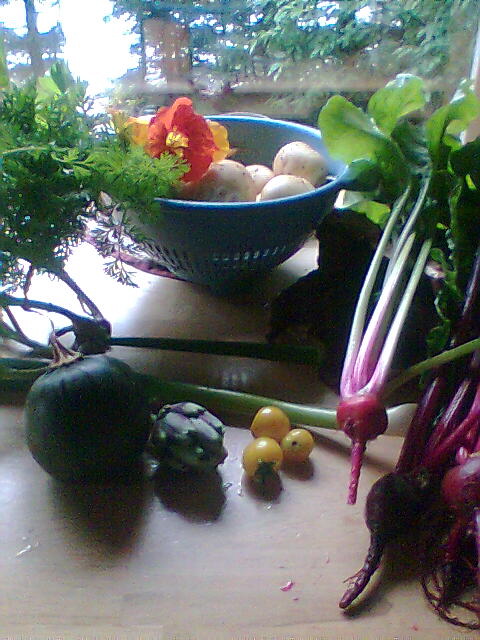The new emphasis on self reliance and eating locally has left many Americans at a disadvantage, in that they don’t have access to the means: gardening space, ability, time, etc. For those who can’t grow their own food directly, which should be the first choice, there’s an excellent alternative, or perhaps halfway measure: Community Supported Agriculture.

Locally grown produce. Nothing like it! (Photo: Michelle Zeiger).
Community Supported Agriculture, commonly known by its initials, CSA, is subscriber supported gardening, in which supporters receive a periodic shipment of fresh produce. Often organic, usually local, or at least regional, this produce generally exceeds the standards of commercially grown, “mass produced” fruits and vegetables.
We used to subscribe to Full Circle Farms in northwest Washington state, which serves a wide area, including Alaska. Shipments came either weekly or every other week, depending on a family’s needs. We would go on line and review the available produce, selecting those we wanted, and listing the quantities within the limits of our subscription level. Each shipment included at least one out of the ordinary, lesser known fruit or vegetable that challenged our status quo. The accompanying newsletter included excellent recipes, usually featuring the unfamiliar produce. In this way, we learned how much we liked fennel root, unfamiliar varieties of mushrooms, sun chokes, and arugula.
Shipments came to a home in our neighborhood, the garage of which remained unlocked during set hours for subscribers to come and pick up boxes. We returned empty boxes to the same location to be shipped back to Full Circle.
Full Circle’s outreach is excellent. They even came to Juneau to host periodic customer appreciation parties with live music and good food, featuring a lot of fresh, organic fruits and vegetables, of course.
This system worked well until we moved to Haines, when our reduced income and shipping uncertainties made the arrangement impractical, but our time as subscribers had a significant, positive impact on our new homestead’s garden.
Our region is experiencing a self reliance resurgence, with a growing emphasis on buying and growing locally. We’ve heard that a CSA organization is getting started in nearby Skagway.
The beauty of CSA is that it enables small farmers to make a decent living while improving the diets and expanding the horizons of the subscribers. As ever, the larger, more well established and organized CSA farms have the broadest reach and best service, but a CSA arrangement can be formed on the smallest level, between neighbors, or even within families. An elderly or infirm person with great garden space might strike an agreement with a younger, more fit neighbor who lacks the space to work their own garden. Homeless members of a town might be granted community garden space to grow food for themselves and others. The combinations and benefits are limited only by the imaginations and resources of the participants.
If you like this idea, you’ll find many CSA organizations on the Internet. For maximum freshness and local benefit, try to find one as close to your home as possible. Visit the farm and get to know the people. See if they can accommodate “sweat equity,” consumer involvement in the gardening. If they do, go for it—the results are highly rewarding.
